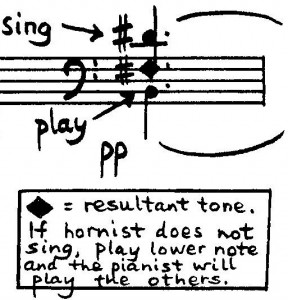Another technique long known but rarely touched upon in print is horn chords, also referred to as vocalizations or multiphonics. Barry Tuckwell in Playing the Horn presents how to play them and also why to play them.
The playing of chords on brass instruments used to be considered a cheap music-hall trick, although Weber uses the effect in the cadenza of his Concertino, even if the printed notes he asks for are not possible. Now, however, it is used by many serious modern composers and must be accepted as a part of the basic horn-playing technique.
To play chords the player must play a note and sing another note with the voice typically a fifth or sixth away. This produces as Tuckwell notes a chord “produced by resultant tones” if the two sounds “are well matched dynamically and are perfectly in tune.” He further notes that
It is for each individual to decide whether to sing above or below the played note; this will depend on the vocal ability and the register required. All intervals other than fifths and sixths produce overtones outside the limits of the tempered scale; third, quarter, there-quarter tones, and so on. If the sung and played notes are brought close together, a definite beat will be heard when the two sounds conflict.
Douglas Hill has a fairly extended discussion of vocalizations in Collected Thoughts on Teaching and Learning, Creativity, and Horn Performance, with exercises designed learn the effect. He suggests the key is “learning how to coordinate the aperture buzz with the voice.”
Traditionally I would also add that it was thought to be an effect more suited to the male voice. However, Hill notes in one of his exercises to “Try the following, either as is or up an octave for higher voices.”
As his book is still available I will leave it to readers to track down his specific suggestions, but for those that would like to try to play a horn chord I would suggest one of the following as a first pair of notes to try, adjusting the voiced note upward as needed. A traditional approach would be to play a low C (an octave below the staff written) and sing the G above it. An alternate would be to play that same low C but sing the E on the bottom line. If you get either interval well in tune magic happens and you will begin to hear another note come in, the resultant tone.
 As to a work to try, as Tuckwell indicated, the Weber Concertino is not written in a way that really works.
As to a work to try, as Tuckwell indicated, the Weber Concertino is not written in a way that really works.
There are a few others to chose from, a favorite of mine being Sonorites II by Walter Hartley, from which this brief example was selected, with instructions by the composer. It is the same chord I suggested trying earlier, but down a half step and showing the resultant tone. The voicing of all the chords in this composition works well for me exactly as written. Composed in 1975 for the late Calvin Smith (“with special thanks to Frank Lloyd”) this short work appears to still be in print and is not heard often enough.
To conclude, horn chords are not an effect for everyone, but are still well worth experimenting with for any player.
Buying or selling something?
Check out Horn Matters Classified Ads!
Please visit our advertising sponsors:
Related articles:
- Hornmasters on Staccato, Part II: Fox, Berv, and Hill Staccato tonguing is a problem for many horn students. In part I of this article Farkas and Schuller laid out...
- Hornmasters on Puffing the Cheeks Next Farkas in The Art of French Horn Playing briefly presents notes on puffing out the cheeks. He felt it...
- Hornmasters: Attacks, a Prelude to Tonguing Tonguing would seem on the surface to be a fairly uncontroversial topic. We have touched on this topic in this...
- Hornmasters: Berv and Tuckwell on the Glissando A topic not mentioned in many classic horn texts is the topic of the glissando. It is a fun effect....
- Hornmasters on Intonation In this series I have generally been starting with a quote from The Art of French Horn Playing. The discussion...
- Hornmasters on Setting the Lips and Breath Attacks This is a topic that is really central to tonguing but not necessarily well taught or understood. To begin, for...
- Hornmasters: Berv and Reynolds on Slurs For Harry Berv in A Creative Approach to the French Horn the concept of “leverage” was essential to a good...